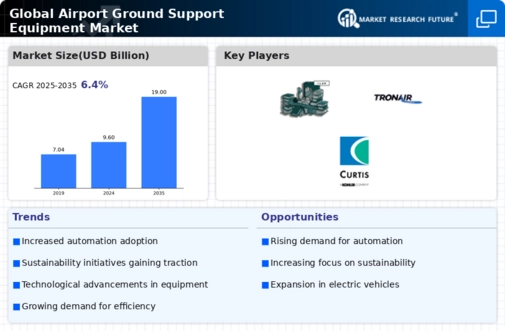Market Trends
Key Emerging Trends in the Airport Ground Support Equipment Market
Market share positioning strategies are crucial for companies operating in the competitive landscape of the airport ground support equipment (GSE) market. One primary strategy involves differentiation through technological innovation. Companies strive to distinguish themselves by investing in research and development to create cutting-edge GSE solutions. By integrating advanced technologies such as electric propulsion, automation, and smart connectivity, manufacturers position themselves as leaders in providing state-of-the-art equipment that enhances operational efficiency and meets the evolving needs of airports globally.
Strategic partnerships and collaborations form another vital market share positioning strategy in the airport GSE sector. Collaborations with airport authorities, airlines, and other industry stakeholders enable GSE manufacturers to align their offerings with specific requirements and gain insights into market trends. Establishing strategic partnerships allows companies to provide comprehensive solutions, including maintenance services and training programs, enhancing their market positioning as trusted and integrated partners in the aviation ecosystem.
A customer-centric approach is integral to successful market share positioning in the airport GSE market. Understanding the unique needs and operational challenges of airports and ground handling service providers enables companies to tailor their GSE solutions accordingly. A focus on customer satisfaction, reliability, and post-sales support positions manufacturers favorably. Building strong relationships with clients and offering customizable GSE solutions enhances market share by fostering brand loyalty and positive referrals within the aviation industry.
Strategic marketing and branding efforts are essential components of market share positioning in the airport GSE sector. Establishing a strong and recognizable brand presence through targeted marketing campaigns, participation in industry events, and thought leadership enhances market visibility. A compelling brand image that communicates reliability, innovation, and a commitment to sustainable practices influences customer perceptions and preferences, contributing to a larger market share.
Cost-effectiveness is a significant market share positioning strategy, particularly in an environment where airports and ground handling service providers closely monitor operational costs. GSE manufacturers that offer competitive pricing without compromising quality and performance gain a competitive advantage. The ability to provide cost-effective solutions positions companies favorably, especially in regions where budget constraints and cost-sensitive procurement practices are prevalent.
Global presence and strategic geographical positioning contribute to market share strategies in the airport GSE market. Establishing a strong international footprint allows companies to access diverse markets, respond effectively to global trends, and address region-specific challenges. Regional partnerships and a deep understanding of local regulations and customer requirements enhance a company's ability to position itself as a global player capable of meeting the varied demands of airports and airlines worldwide.
Innovation in sustainability initiatives and environmentally conscious technologies is gaining prominence as a market share positioning strategy. Manufacturers in the airport GSE market are exploring eco-friendly materials, energy-efficient systems, and sustainable production processes to align with global efforts toward sustainability. This strategy reflects a growing awareness of the environmental impact of aviation operations and positions companies as contributors to global environmental responsibility, appealing to clients with a focus on ethical and sustainable practices.
Customization for specific airport requirements and mission profiles is a prevalent market share positioning strategy. With the diverse needs of airports and ground handling operations, companies that offer GSE solutions tailored to meet specific specifications gain market traction. Customizable features, adaptability to various aircraft types, and compatibility with different ground handling functions contribute to market share positioning by ensuring optimal integration into specific airport environments.
Strategic diversification into emerging markets and niche segments is a market share positioning strategy that allows companies to tap into new opportunities. This may involve expanding into markets for specific types of GSE, such as electric tow tractors or autonomous baggage carts, or targeting emerging players in the aviation industry. Diversification strategies enable companies to broaden their market presence and capture untapped segments, contributing to increased market share.






Leave a Comment